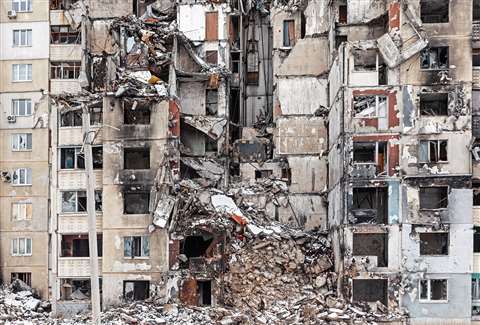Ukraine war: What will reconstruction of damaged buildings and infrastructure cost?
18 April 2023
 A destroyed apartment building in Kharkhiv, Ukraine (Image by misu via AdobeStock - stock.adobe.com)
A destroyed apartment building in Kharkhiv, Ukraine (Image by misu via AdobeStock - stock.adobe.com)
It’s over a year since Russia began its invasion of Ukraine and with no end to the war in sight, the reconstruction bill already runs to hundreds of billions of dollars.
In fact, a new report by the World Bank, government of Ukraine, the European Commission and the United Nations has found that direct damage to buildings and infrastructure in the country already totals more than US$135 billion.
Within that total, the most affected areas are:
- Housing (37%)
- Transport (26%)
- Energy (8%)
- Commerce and industry (8%)
- Agriculture (6%)
Around 8.2% of the country’s total housing stock is estimated to be either damaged or destroyed.
The figures come from an updated Ukraine Recovery and Reconstruction Needs Assessment (RDNA2), which now estimates the total cost of reconstruction and recovery in Ukraine at US$411 billion from 24 February 2022 to 24 February 2023.
The cost of reconstruction and recovery is expected to stretch over 10 years and will require huge levels of funding from both public and private sources.
Damage is concentrated around the frontline regions of Donetsk, Kharkiv, Luhansk, Zaporizhzhia, Kherson, Mykolaiv, and areas brought back under Ukraine’s control such as Kyiv and Chernihiv.
However, damage since 1 June 2022 has also not escalated as much as might have been predicted, according to the report. That’s because while the war has intensified around certain frontline regions, there has been more limited change in frontline areas than in the first three months of Russia’s invasion.
The total estimated cost of reconstruction and recovery of US$411 billion considers surging pricing in construction, higher insurance premiums and a shift towards more modern building design and renewable energy.
The highest estimated needs are in:
- Transport (22%)
- Housing (17%)
- Energy (11%)
- Social protection and livelihoods (10%)
- Explosive hazard management (9%)
- Agriculture (7%)
Preparations already underway
Despite the fact that the war rages on, preparations are already underway for Ukraine’s reconstruction.
The European Construction Industry Federation (FIEC) helped to organise an event in Warsaw, Poland, in February this year called Rebuild Ukraine, led by Ukrainian member federation the CBU.
 A building in Hostomel, Ukraine, after it was hit by a missile (Image: Chivery via AdobeStock - stock.adobe.com)
A building in Hostomel, Ukraine, after it was hit by a missile (Image: Chivery via AdobeStock - stock.adobe.com)
It brought together different actors to prepare and participate in the reconstruction of the country once conditions are right to do so.
It attempted to connect European construction companies and investors in the sector to accelerate reconstruction work of affected communities once it can begin. A total of 3,000 people from 50 different countries attended the first event, including from the European Bank for Reconstruction and Development (EBRD), the European Investment Bank (EIB) and the World Bank
Another forum is planned later this year on 14-15 November in Warsaw.
Ukrainian authorities stressed that their country will need to be rebuilt from scratch, in accordance with European technical, environmental, social and political standards with the aim of becoming the 28th member state of the European Union.
FIEC president Philip Crampton said, “The primary goal is to rebuild Ukraine in accordance with European standards: technical, environmental, social and political – on the highest ethical grounds.
“The reconstruction needs to start as soon as possible to get the economy of Ukraine back on track.”
Following a number of meetings FIEC and the CBU, the Task Force FIEC – EIC “Ukraine” has been created. It unites all European construction business for the future reconstruction of Ukraine.
Meetings of the Task Force have so far discussed how the European construction industry can support Ukraine, including the training of Ukrainian builders abroad, with initiatives in Slovakia and Belgium already underway.
Challenges
However, beyond the uncertainty of when and how the war itself will end, is the challenge of the administration of any eventual reconstruction programme.
While it has been suggested that the model should be the Marshal Plan, which saw rebuilding across Europe between 1947 and 1951 after the devastation of World War II, that plan involved one country – the US, donating money to 16 European countries.
In considering the reconstruction of Ukraine, the Brookings Institution has pointed out that the plan would work in reverse, with many donor countries and institutions contributing to the reconstruction of one country, and that could lead to complications when it comes to co-ordinating financing and delivery.
To that end, the European Union launched a Multi-agency Donor Coordination Platform earlier this year. It aims to allow close co-ordination among international donors and financial organisations that will help pay for reconstruction.
 Delegates at the ReBuild Ukraine event on 15-16 February 2023 (Image: ReBuild Ukraine)
Delegates at the ReBuild Ukraine event on 15-16 February 2023 (Image: ReBuild Ukraine)
Speaking at the Rebuild Ukraine forum in February this year, Dr Kirsten Scholl, director-general of European policy in Germany’s federal ministry for economic affairs and climate action said, “The reconstruction cannot begin only after the war has come to an end. We need to look now at what can be repaired and rebuilt immediately: hospitals, schools, train stations and the energy infrastructure.”
Speaking to International Construction, CBU president Lev Partskhaladze said, “It is difficult to rebuild the country while the fighting is going on, but we understand that it is possible to rebuild now. In particular, we are talking about the facilities design and some territories planning, which takes a lot of time.
“CBU actively collaborates with international partners. We are trying to prove that it is possible to invest in Ukraine and collaborate with Ukraine.
“At the first meetings with international associations, companies, governments, we offered to choose any affected settlement to be rebuilt, to which the respective country will be assigned. After having spoken a lot with business, heads of affected communities, we understood that it is necessary not just to rebuild what has been destroyed but in general think over the projects with full infrastructure provided.”
Work underway
The CBU is overseeing work to begin the process of reconstruction. That includes organising training for Ukrainian communities to teach them how to properly develop documentation on the damage and where to submit it.
 CBU president Lev Partskhaladze (Image courtesy of the CBU)
CBU president Lev Partskhaladze (Image courtesy of the CBU)
The CBU is also working to inform communities about existing recovery and regional development support programmes, along with the features and conditions of their financing.
Meanwhile, it is engaging with Ukrainian and interested foreign building companies about the reconstruction of Ukraine.
Some CBU member companies are already actively involved in rebuilding the partially or fully destroyed or damaged facilities;
And together with FIEC, European International Contractors (EIC), and the Confederation of International Contractors’ Association (CICA), the CBU has developed Recommendations for the Future Reconstruction of Ukraine.
Launched this week (19 April) the eight-point recommendations on how to rebuild Ukraine are:
1) Build back, but better and quicker but without reducing quality.
2) In anticipation of accession of Ukraine to the EU, buildings and infrastructures should be rebuilt in accordance with European standards.
3) The preparation phases of the projects is of utmost importance and should be modernised.
4) Ukrainian authorities, EU Institutions and multilateral development banks (MDBs) should use procurement methods which prevent corruption.
5) International contract standards (FIDIC, etc.) should be applied to speed up negotiations and contract awards.
6) Local financing channels and invoice approval procedures should be simplified.
7) The bank guarantees system should be simplified and harmonised to reduce their cost.
8) The private sector should be encouraged to long-term investments, e.g. by first-loss public guarantees.
CBU members are also working with government officials on regulatory and legal changes to simplify construction procedures and improve the investment climate for the post-war reconstruction of Ukraine.
Partskhaladze said, “It is important that Ukrainians return and have the opportunity to work in their own towns or nearby. It is necessary to create jobs for our citizens by locating foreign companies in the territory of Ukraine.”
And he added his own expectations for how long Ukrain’s reconstruction could take.
He said, “We have positive expectations because we count on international support and some western countries have already expressed a desire to finance the reconstruction of Ukraine.
“In case of positive developments of events, I think it can take 10 to 15 years to completely rebuild the destroyed facilities.”
Using rubble to rebuild
Meanwhile, a French company specialising in the recycling of used materials has suggested that it can recycle and reuse rubble from buildings destroyed in the Ukraine war to build up to 450 apartments in Hostomel, north-west of Kyiv.
Neo-Eco has set out plans for a three-stage process that could help with the reconstruction of housing in Hostomel, working in partnership with charity Resilience Ukraine. It would involve first analysing existing objects and materials before dismantling damaged buildings.
They would then to sort items like windows and doors for repair or recycling, before sorting metal, wood and concrete and bricks.
Neo-Eco claims it can recycle up to 98% of the debris. Among the items it could recycled are: concrete and brick which would be turned into aggregates; wooden doors to be turned into particle board; plaster to be turned into plasterboard; and glass and PVC to be turned into glass cullet, aluminium and PVC.
In the third phase, those repaired and recycled materials would be used to construct new buildings.
Neo-Eco has won initial funding from France for a pilot project in Hostomel, where Russia destroyed buildings and the local airport during its invasion in February 2022.
But it needs more donors to raise a total of €30 million (US$32.6 million).
The goal of the project is to rebuild the town and create modern urban neighbourhoods using the principles of a circular economy by 2024.
CONNECT WITH THE TEAM





